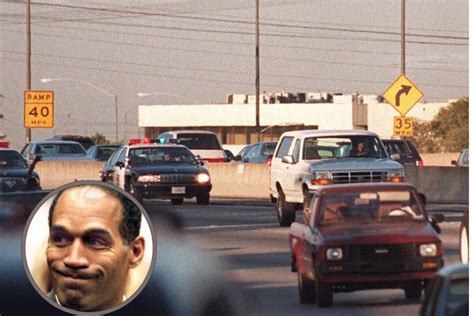
On June 17, 1994, a nation was captivated as O.J. Simpson, wanted in connection with the murders of his ex-wife Nicole Brown Simpson and Ronald Goldman, led police on a slow-speed chase in a white Ford Bronco, an event forever etched in sports and American cultural history.
The surreal scene unfolded live on television, preempting coverage of the NBA Finals and the World Cup, drawing an estimated 95 million viewers. The chase, which began in Orange County and ended at Simpson’s Brentwood estate, was more than a pursuit; it was a bizarre spectacle that blended crime, celebrity, and the burgeoning 24-hour news cycle. “It was a historic day in sports when The Juice got loose,” as Yahoo Sports described it. The event continues to be analyzed and debated, representing a pivotal moment in media, law enforcement, and public perception.
The events leading up to the chase began with the brutal murders of Nicole Brown Simpson and Ronald Goldman on June 12, 1994, at Nicole’s Brentwood condominium. Simpson quickly became the prime suspect. Initially cooperating with authorities, he agreed to surrender on June 17. However, instead of turning himself in, Simpson, accompanied by his friend Al Cowlings (A.C.), fled in Cowlings’ white Ford Bronco. This decision initiated the low-speed pursuit that captured the world’s attention.
News helicopters hovered above, broadcasting live footage as the Bronco crept along the Los Angeles freeways. Police cruisers followed at a cautious distance. The atmosphere was tense, a mix of morbid curiosity and genuine concern. As the Bronco moved, crowds gathered on overpasses, holding signs and cheering, a surreal manifestation of the public’s fascination.
Inside the Bronco, Simpson was reportedly armed and distraught. A.C. Cowlings, who was driving, communicated with police negotiators, relaying Simpson’s emotional state and demands. At one point, Simpson reportedly threatened to harm himself. The slow speed of the chase— averaging around 35 miles per hour—allowed for extensive media coverage and widespread public engagement.
The chase culminated at Simpson’s Brentwood estate. After lengthy negotiations with police, Simpson eventually surrendered. He was taken into custody and subsequently charged with the murders of Nicole Brown Simpson and Ronald Goldman.
The O.J. Simpson case, and particularly the Bronco chase, marked a turning point in media coverage of crime and celebrity. It demonstrated the power of live television and the public’s insatiable appetite for sensational news. The trial that followed was equally captivating, often referred to as the “Trial of the Century,” further solidifying the case’s place in American cultural consciousness.
The chase was not merely a police pursuit; it was a cultural phenomenon. It exposed deep-seated racial tensions, issues of celebrity privilege, and the pervasive influence of media in shaping public perception. The image of the white Bronco remains a potent symbol, instantly recognizable and deeply evocative of a complex and controversial chapter in American history.
The event highlighted the evolving role of television news. The immediacy and drama of live coverage transformed the way news was consumed and disseminated. Networks broke into regular programming to broadcast the chase, recognizing the immense public interest. This decision set a precedent for future coverage of high-profile events, particularly those involving celebrities and criminal investigations.
The Bronco chase also had a significant impact on law enforcement procedures. The slow-speed pursuit was a deliberate tactic, aimed at minimizing the risk of a violent confrontation. While criticized by some, it ultimately led to Simpson’s peaceful surrender. The event prompted discussions and reviews of police protocols for handling similar situations, emphasizing the importance of negotiation and de-escalation.
In the years since, the O.J. Simpson case has been the subject of numerous books, documentaries, and television series. These works continue to explore the complexities of the case, examining the evidence, the legal strategies, and the social and cultural context in which the events unfolded. The Bronco chase remains a central element of the narrative, a visual representation of the drama and uncertainty that defined the entire saga.
The legacy of the O.J. Simpson case extends beyond the legal and media realms. It has had a lasting impact on American society, prompting ongoing conversations about race, class, and justice. The case has been cited in discussions about the criminal justice system, police brutality, and the role of celebrity in shaping public opinion.
The Bronco chase serves as a stark reminder of the power of images and the enduring fascination with crime and celebrity. It was a moment when the nation paused, captivated by a drama that blurred the lines between reality and spectacle. The events of June 17, 1994, continue to resonate, shaping our understanding of media, law enforcement, and the complexities of American culture.
The slow pursuit involving O.J. Simpson in the white Ford Bronco wasn’t just a car chase; it was a bizarre spectacle that exposed deep-seated issues within American society. The fact that it preempted coverage of the NBA Finals and the World Cup underscored its significance, highlighting the public’s insatiable appetite for sensational news. The event’s impact is still felt today, reminding us of the profound intersection of crime, celebrity, and media in contemporary culture.
The chase’s route through the Los Angeles freeways became an impromptu parade. Spectators lined overpasses, holding signs of support and capturing the moment with cameras. This peculiar form of public engagement showed the widespread fascination and, for some, even support for Simpson, despite the serious allegations against him.
The chase was also notable for its impact on television news. Networks interrupted regular programming to provide live coverage, realizing the event’s newsworthiness. This decision set a new standard for covering high-profile events and contributed to the growth of 24-hour news channels, which thrive on immediacy and sensationalism.
The role of Al Cowlings cannot be overlooked. As the driver of the Bronco and a close friend of Simpson, he served as a negotiator between Simpson and the police. His communication with law enforcement was crucial in preventing a potentially violent confrontation and eventually securing Simpson’s surrender.
The media frenzy surrounding the Bronco chase also raised ethical questions about journalistic practices. The intense competition among news outlets to capture the best footage and obtain exclusive information sometimes led to questionable tactics and a blurring of lines between reporting and sensationalism.
The legacy of the O.J. Simpson case extends beyond the legal and media realms, prompting ongoing discussions about race, class, and justice in America. The events of June 17, 1994, remain a potent symbol of a complex and controversial chapter in American history.
The extensive coverage of the O.J. Simpson case has had a lasting impact on how the public perceives the criminal justice system. Many view the trial and its aftermath as a reflection of systemic biases and inequalities, sparking debates about the fairness and impartiality of the legal process.
The details of the Bronco chase have been revisited and re-examined in numerous books, documentaries, and television series. These analyses often focus on the cultural and societal factors that contributed to the event’s significance, highlighting the interplay of race, celebrity, and media in shaping public opinion.
The slow speed of the chase was a deliberate tactic used by law enforcement to minimize the risk of a violent confrontation. While it allowed for extensive media coverage, it also raised questions about the appropriateness of the police response and the potential for a more aggressive approach.
The Bronco chase became a cultural touchstone, influencing popular culture in various ways. It has been referenced in films, television shows, and music, often serving as a symbol of the O.J. Simpson case and its broader implications.
The events of June 17, 1994, continue to resonate in American society, shaping our understanding of media, law enforcement, and the complexities of race, class, and justice. The Bronco chase remains a potent symbol of a pivotal moment in American history.
The chase underscored the evolving role of television news, with networks breaking into regular programming to broadcast the event live. This decision set a precedent for future coverage of high-profile incidents, particularly those involving celebrities and criminal investigations.
The Bronco chase also had a significant impact on law enforcement procedures. The slow-speed pursuit was a deliberate tactic, aimed at minimizing the risk of a violent confrontation. While criticized by some, it ultimately led to Simpson’s peaceful surrender. The event prompted discussions and reviews of police protocols for handling similar situations, emphasizing the importance of negotiation and de-escalation.
The sheer spectacle of the chase—the white Bronco, the slow speed, the crowds on the overpasses—created a surreal atmosphere that captivated the nation. It was a moment when reality seemed stranger than fiction, blurring the lines between crime drama and live entertainment.
The role of the media in shaping public perception of the O.J. Simpson case cannot be overstated. The constant coverage, the sensational headlines, and the graphic images all contributed to a narrative that was both compelling and divisive.
The Bronco chase also highlighted the issue of celebrity privilege, with many questioning whether Simpson was treated differently because of his fame and wealth. This perception further fueled the controversy surrounding the case and contributed to the public’s distrust of the criminal justice system.
The events of June 17, 1994, continue to be analyzed and debated, representing a pivotal moment in media, law enforcement, and public perception. The Bronco chase remains a potent symbol of a complex and controversial chapter in American history.
The chase exposed deep-seated racial tensions, issues of celebrity privilege, and the pervasive influence of media in shaping public perception. The image of the white Bronco remains a potent symbol, instantly recognizable and deeply evocative of a complex and controversial chapter in American history.
The slow pursuit involving O.J. Simpson in the white Ford Bronco wasn’t just a car chase; it was a bizarre spectacle that exposed deep-seated issues within American society. The fact that it preempted coverage of the NBA Finals and the World Cup underscored its significance, highlighting the public’s insatiable appetite for sensational news. The event’s impact is still felt today, reminding us of the profound intersection of crime, celebrity, and media in contemporary culture.
The slow speed of the pursuit allowed for extensive media coverage, enabling news outlets to broadcast the chase live and provide commentary. This saturation coverage amplified the event’s impact and solidified its place in American cultural history.
The Bronco chase was not merely a police pursuit; it was a cultural phenomenon. It exposed deep-seated racial tensions, issues of celebrity privilege, and the pervasive influence of media in shaping public perception. The image of the white Bronco remains a potent symbol, instantly recognizable and deeply evocative of a complex and controversial chapter in American history.
The trial that followed the chase was equally captivating, often referred to as the “Trial of the Century,” further solidifying the case’s place in American cultural consciousness. The trial exposed deep divisions within American society and raised questions about the fairness and impartiality of the criminal justice system.
The O.J. Simpson case, and particularly the Bronco chase, marked a turning point in media coverage of crime and celebrity. It demonstrated the power of live television and the public’s insatiable appetite for sensational news. The trial that followed was equally captivating, often referred to as the “Trial of the Century,” further solidifying the case’s place in American cultural consciousness.
The Bronco chase serves as a stark reminder of the power of images and the enduring fascination with crime and celebrity. It was a moment when the nation paused, captivated by a drama that blurred the lines between reality and spectacle. The events of June 17, 1994, continue to resonate, shaping our understanding of media, law enforcement, and the complexities of American culture.
The chase underscored the evolving role of television news, with networks breaking into regular programming to broadcast the event live. This decision set a precedent for future coverage of high-profile incidents, particularly those involving celebrities and criminal investigations.
The Bronco chase also had a significant impact on law enforcement procedures. The slow-speed pursuit was a deliberate tactic, aimed at minimizing the risk of a violent confrontation. While criticized by some, it ultimately led to Simpson’s peaceful surrender. The event prompted discussions and reviews of police protocols for handling similar situations, emphasizing the importance of negotiation and de-escalation.
FAQ:
1. What exactly happened during the O.J. Simpson Bronco chase?
On June 17, 1994, O.J. Simpson, a suspect in the murders of his ex-wife Nicole Brown Simpson and Ronald Goldman, failed to surrender to authorities as agreed. Instead, he and his friend Al Cowlings (A.C.) led police on a slow-speed chase in Cowlings’ white Ford Bronco through the Los Angeles area. The chase was broadcast live on television, captivating an estimated 95 million viewers. Simpson eventually surrendered at his Brentwood estate after negotiations with police.
2. Why was the Bronco chase so significant?
The O.J. Simpson Bronco chase was significant for several reasons:
- Media Spectacle: It was one of the first major events to be broadcast live on television in real-time, captivating a massive audience and transforming the way news was consumed.
- Cultural Phenomenon: It became a cultural touchstone, sparking discussions about race, class, celebrity, and the criminal justice system.
- Legal Implications: It set the stage for the “Trial of the Century,” which further amplified the case’s impact on American society.
- Law Enforcement Impact: It influenced law enforcement procedures, particularly in handling high-profile suspects and negotiating peaceful surrenders.
3. Who was Al Cowlings and what role did he play in the chase?
Al Cowlings (A.C.) was a close friend of O.J. Simpson and the driver of the white Ford Bronco during the chase. He played a crucial role as a negotiator between Simpson and the police. Cowlings communicated with law enforcement, relaying Simpson’s emotional state and demands, which ultimately contributed to Simpson’s peaceful surrender.
4. What was the public reaction to the Bronco chase?
The public reaction to the Bronco chase was a mix of fascination, shock, and morbid curiosity. Crowds gathered on overpasses to watch the chase unfold, holding signs of support and capturing the moment with cameras. The event preempted coverage of major sporting events like the NBA Finals and the World Cup, highlighting the intense public interest. The chase also sparked debates about Simpson’s guilt or innocence, as well as the role of celebrity and race in the criminal justice system.
5. What lasting impact did the O.J. Simpson case and the Bronco chase have on American society?
The O.J. Simpson case and the Bronco chase had a profound and lasting impact on American society:
- Media Coverage: It transformed media coverage of crime and celebrity, leading to the rise of 24-hour news channels and a greater focus on sensationalism.
- Legal System: It raised questions about the fairness and impartiality of the criminal justice system, particularly concerning race and class biases.
- Cultural Consciousness: It became a cultural touchstone, shaping discussions about race relations, celebrity privilege, and the role of media in shaping public opinion.
- Law Enforcement: It influenced law enforcement procedures, emphasizing the importance of negotiation and de-escalation in handling high-profile suspects. The events continue to be analyzed and debated, representing a pivotal moment in media, law enforcement, and public perception.









